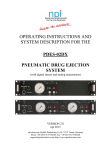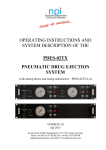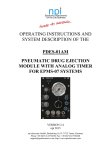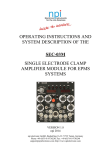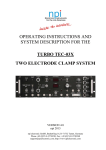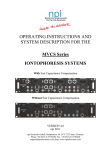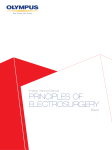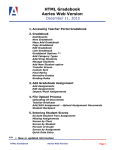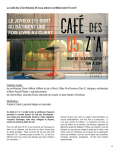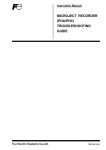Download PDES-02D Manual - ALA Scientific Instruments
Transcript
OPERATING INSTRUCTIONS AND SYSTEM DESCRIPTION FOR THE PDES-02DX PNEUMATIC DRUG EJECTION SYSTEM VERSION 1.0 npi 2008 npi electronic GmbH, Hauptstrasse 96, D-71732 Tamm, Germany Phone +49 (0)7141-9730230; Fax: +49 (0)7141-9730240 [email protected]; http://www.npielectronic.com PDES-02DX User Manual ___________________________________________________________________________ Table of Contents 1. 2. Safety Regulations............................................................................................................ 3 PDES-02DX System ........................................................................................................ 4 2.1. System Description...................................................................................................... 4 2.2. Description of the Front Panel..................................................................................... 5 2.3. Description of the Rear Panel...................................................................................... 7 2.4. Operation ..................................................................................................................... 8 3. Literature .......................................................................................................................... 11 4. Technical Data.................................................................................................................. 12 ___________________________________________________________________________ version 1.0 page 2 PDES-02DX User Manual ___________________________________________________________________________ 1. Safety Regulations VERY IMPORTANT: Instruments and components supplied by npi electronic are NOT intended for clinical use or medical purposes (e.g. for diagnosis or treatment of humans), or for any other life-supporting system. npi electronic disclaims any warranties for such purpose. Equipment supplied by npi electronic must be operated only by selected, trained and adequately instructed personnel. For details please consult the GENERAL TERMS OF DELIVERY AND CONDITIONS OF BUSINESS of npi electronic, D-71732 Tamm, Germany. 1) 2) 3) 4) 5) GENERAL: This system is designed for use in scientific laboratories and must be operated by trained staff only. General safety regulations for operating electrical devices should be followed. AC MAINS CONNECTION: While working with the npi systems, always adhere to the appropriate safety measures for handling electronic devices. Before using any device please read manuals and instructions carefully. The device is to be operated only at 115/230 Volt 60/50 Hz AC. Please check for appropriate line voltage before connecting any system to mains. Always use a three-wire line cord and a mains power-plug with a protection contact connected to ground (protective earth). Before opening the cabinet, unplug the instrument. Unplug the instrument when replacing the fuse or changing line voltage. Replace fuse only with an appropriate specified type. STATIC ELECTRICITY: Electronic equipment is sensitive to static discharges. Some devices such as sensor inputs are equipped with very sensitive FET amplifiers, which can be damaged by electrostatic charge and must therefore be handled with care. Electrostatic discharge can be avoided by touching a grounded metal surface when changing or adjusting sensors. Always turn power off when adding or removing modules, connecting or disconnecting sensors, headstages or other components from the instrument or 19” cabinet. TEMPERATURE DRIFT / WARM-UP TIME: All analog electronic systems are sensitive to temperature changes. Therefore, all electronic instruments containing analog circuits should be used only in a warmed-up condition (i.e. after internal temperature has reached steady-state values). In most cases a warm-up period of 20-30 minutes is sufficient. HANDLING: Please protect the device from moisture, heat, radiation and corrosive chemicals. HIGH PRESSURE PRECAUTIONS: While working with PDES systems and components, always adhere to the appropriate safety measures for handling high pressure pneumatic systems. Before using the PDES or any external pneumatic device please read the manual and instructions carefully. • Always turn off pressure source before connecting or disconnecting the PDES system. • Any component used (tubes, fittings etc.) must be specified for the maximum possible pressure. • Do not use any aggressive, combustible or explosive gases. Only gases such as air, nitrogen, carbon dioxide, helium, etc. are allowed. • Use only dry, oil free, filtered gases (max. 5 µm filter is allowed). • Maximum input pressure must be below 5 bar (1 bar = 100,000 Pa). npi recommends an input pressure of 1 bar more than the maximum output pressure. ___________________________________________________________________________ version 1.0 page 3 PDES-02DX User Manual ___________________________________________________________________________ 2. PDES-02DX System 2.1. System Description Pressure ejection is a convenient method for applying both ionic and non-ionic solutions from micropipettes. This method is popular for two reasons. First, it can apply to almost all solutions. Second, the amount of solution ejected can be monitored by viewing the tip of the micropipette under a microscope. The PDES-02DX is designed for pressure ejection of drugs in physiological and pharmacological studies. PDES systems are equipped with high pressure outputs (Pmax = 2 bar / 29 psi or 4 bar / 58 psi) for drug application with fine-tipped micropipettes, but can also be operated in low-range pressure for controlled droplet application from large-tipped pipettes. Digital timers and a remote control unit facilitate the use of these instruments. In order to speed up drug ejection, PDES-02DX systems are available with the microJect option. These systems are equipped with a micro valve located in an injection holder. The micro valve has a switch time of less than 1 ms and a very small volume that has to be controlled, resulting in application times in the ms range. The PDES-02DX is housed in a 19" cabinet that can be mounted in a rack. It comprises of two identical channels. Each channel consists of a precision pressure regulator, an analog pressure display, electronically controlled valves, control electronics and a regulated power supply. Ejection of drugs can be activated manually or via a TTL input. The operational status is indicated by a red/green LED. The pressure output is monitored at a BNC output (1V / bar) and additionally the signal for pressure control is available via TTL OUT BNC connector. Mode of operation and timing is selected by controls at the front panel. If the internal timer is used, the eject time is preset by a control. Each channel can be turned off by using a switch that is combined with the timing control. The operational status is indicated by a red/green LED. Red means that the channel has been turned on and the valve is closed, green indicates that the valve is open and injection takes place. The remote control unit (option) is housed in a small box. It has a red LED that indicates if the respective channel is turned on and a toggle switch with a temporary and a fix position for starting drug application. The pressure connectors (quick connect type) are located at the rear panel of the instrument. Each channel is equipped with an INPUT coupling where the pressure source is connected, an OUTPUT coupling where the injection pipette is connected. The injection pressure is preset by a precision pressure regulator. The pressure is displayed on a manometer. Additional pneumatic devices (tubes, fittings connectors, filters etc.) are available. Please contact npi electronic for details. A calibration procedure allowing quantitative drug application is described by Hofmeier and Lux (1981) (see chapter 3). ___________________________________________________________________________ version 1.0 page 4 PDES-02DX User Manual ___________________________________________________________________________ 2.2. Description of the Front Panel Figure 1: PDES-02DX front panel view (the numbers are related to those in the text below) ___________________________________________________________________________ version 1.0 page 5 PDES-02DX User Manual ___________________________________________________________________________ In the following description of the front panel elements, each element has a number that is related to that in Figure 1. The number is followed by the name (in uppercase letters) written on the front panel and the type of the element (in lowercase letters). Then, a short description of the element is given. Since both channels are identical, only one channel is described. (1) POWER push button Push button to turn POWER on or off (2) Pressure regulator Rotary knob for regulating the pressure (3) Manometer Digital display for the pressure (X.XX bar or XXX.X psi) (4) ON / EJECT LED Indicates the operational status red light: channel has been turned on, valve is closed green light: valve is open or valve not connected (5) TIME (ms) tumble-wheel switch Five digit tumble-wheel switch to set the ejection time (XXXX.X ms) in TIMER mode (6) START button Push button to start operation. The START button can be used to start ejection in TIMER or EXT. mode. In TIMER mode pressing the START button opens the valve for the time set by #5. In EXT. mode pressing the START button opens the valve as long as the button is pressed (7) TTL INPUT connector BNC connector for external operation In TIMER mode a TTL HI ( +5V) signal opens the valve for the time set by #5. In EXT. mode a TTL HI ( +5V) signal opens the valve as long as the signal level is HI (8) TIMING MONITOR connector BNC connector providing a TTL signal that indicates the status of the regulated injection valve (HI = valve open, LO = valve closed) (9) TIMER A, EXT., CONT. switch Switch to set the operation mode (see also chapter 2.4) (10) REMOTE CONTROL connector Connector for the REMOTE CONTROL unit (see Figure 3) ___________________________________________________________________________ version 1.0 page 6 PDES-02DX User Manual ___________________________________________________________________________ 2.3. Description of the Rear Panel Figure 2: PDES-02DX rear panel view (the numbers are related to those in the text below) The following connectors are located at the rear panel. Since both channels are identical, only one channel is described. (1) OUT connector Connector for connecting the ejection pipette holder. The EJECT pressure is supplied to this connector. (2) EXHAUST connector Connector for connecting the HOLD pressure source. If no HOLD pressure is connected, the system is exhausted as long as no pressure is applied to the pipette. (3) SOURCE IN connector Connector for connecting the filtered, dry and oil-free gas source (5 bar max.). Note: npi recommends an input pressure of 1 bar more than the maximum output pressure. (4) FUSE Unplug the instrument when replacing the fuse or changing line voltage. Turn knob to open. Replace fuse only with an appropriate specified type (see chapter 4) (5) Voltage SELECTOR Rotary switch for selecting the operating voltage (115 V / 230 V). Caution: Always switch to the appropriate voltage before connecting the PDES to power. (6) GROUND This connector is linked to the internal system ground which has no connection to the 19" cabinet (CHASSIS) and the mains ground to avoid ground loops. (7) CHASSIS This connector is linked to mains ground (green / yellow wire, protective earth). ___________________________________________________________________________ version 1.0 page 7 PDES-02DX User Manual ___________________________________________________________________________ 2.4. Operation Connect the gas source to the SOURCE IN connector at the rear panel. The gas source must be clean and filtered by a 5 µm filter element. Important: Do not connect sources of OXYGEN or COMBUSTIBLE gases!! The gas source MUST be dry and oil free!! Please use a degreaser and filter the gas source by a 5 µm filter element. Connect ejection micropipette to the OUTPUT connector at the rear panel. If required, connect HOLD pressure to the EXHAUST coupling at the rear panel. Turn on pressure and adjust the EJECTION pressure to the desired value using the pressure regulator. Connect a digital timing unit to the TTL INPUT BNC connector at the front panel. For remote operation connect the remote control unit (option) to the REMOTE CONTROL connector. Turn channel on (TIMER control). The LED is red when no ejection occurs and green when the pressure is applied to the pipette. Select the operation mode using the respective toggle switch at the front panel (see Figure 1). • In the CONT. position the application can be controlled manually, i.e. as long as the CONT. position is set pressure is applied to the pipette. • In the EXT. position the duration of the application is determined directly by the duration of the TTL pulse. • In the TIMER position the duration is preset by the timer control and time base of the PDES. Use the START button to test the system. The START button can be used to start ejection in TIMER or EXT. mode. In TIMER mode pushing the START button starts ejection for the time set by the timer control (#5, Figure 1). In EXT. mode ejection lasts as long as the START button is pushed. ___________________________________________________________________________ version 1.0 page 8 PDES-02DX User Manual ___________________________________________________________________________ REMOTE CONTROL (option): The selected operation mode (at the controller) determines the way the REMOTE CONTROL works. • In the CONT. mode the remote control unit is disabled. • In the EXTERN mode the valve is open as long the REMOTE control switch is activated (CONT./TIMED = continuous, START = temporarily). • In the TIMER mode the internal timer is triggered once by activation of the REMOTE control switch (CONT./TIMED or START). The green LED indicates which channel has been turned on. Figure 3: PDES remote control Note: Green LED indicates that the valve is not connected properly or continuous operation. ___________________________________________________________________________ version 1.0 page 9 PDES-02DX User Manual ___________________________________________________________________________ Figure 4: operation modes of the PDES-02DX ___________________________________________________________________________ version 1.0 page 10 PDES-02DX User Manual ___________________________________________________________________________ 3. Literature Bickmeyer, U., Heine, M., Manzke, T., & Richter, D. W. (2002). Differential modulation of Ih by 5-HT receptors in mouse CA1 hippocampal neurons. Eur.J.Neurosci. 16, 209218. Guzman, J. N., Hernandez, A., Galarraga, E., Tapia, D., Laville, A., Vergara, R., Aceves, J., & Bargas, J. (2003). Dopaminergic modulation of axon collaterals interconnecting spiny neurons of the rat striatum. J Neurosci. 23, 8931-8940. Hahnel, C. (1992). Quantitative Microinjection, in: H. Kettenmann and R. Grantyn (eds.) Practical Electrophysiological methods, Wiley-Liss, New York. Hanganu, I. L. & Luhmann, H. J. (2004). Functional Nicotinic Acetylcholine Receptors on Subplate Neurons in Neonatal Rat Somatosensory Cortex. Journal of Neurophysiology 92, 189-198. Heck, N., Kilb, W., Reiprich, P., Kubota, H., Furukawa, T., Fukuda, A., & Luhmann, H. J. (2006). GABA-A Receptors Regulate Neocortical Neuronal Migration In Vitro and In Vivo. Cereb Cortex. doi:10.1093/cercor/bhj135 Hofmeier, G & Lux, H. D. (1981). The time course of intracellular free calcium and related electrical effects after injection of CaCl2 into neurons of the snail Helix pomatia, Pflügers Arch. 391, 242-251. Lalley, P.M. (1999) Microiontophoresis and Pressure Ejection, in: U. Windhorst, and H. Johansson (eds) Modern Techniques in Neuroscience Research, Springer, Berlin Heidelberg, New York. Misgeld, U. (1992). Droplet application of Agonists, in: H. Kettenmann and R. Grantyn (eds.) Practical Electrophysiological methods. Wiley-Liss, New York Partridge, L. D., Zeilhofer, H. U. & Swandulla, D. (1998). Combined Whole-Cell and Single-Channel Current Measurement with Quantitative Ca2+ Injection or Fura-2 Measurement of Ca2+. In P.M. Conn (Ed.) Ion Channels Part B, Methods in Enzymology 293, Academic Press San Diego. Ponimaskin, E., Dumuis, A., Gaven, F., Barthet, G., Heine, M., Glebov, K., Richter, D. W., & Oppermann, M. (2005). Palmitoylation of the 5-Hydroxytryptamine4a Receptor Regulates Receptor Phosphorylation, Desensitization, and {beta}-Arrestin-Mediated Endocytosis. Molecular Pharmacology 67, 1434-1443. Wetzel C. H., Oles, M., Wellerdieck, C., Kuczkowiak, M., Gisselmann, G. and H. Hatt (1999) Specificity and Sensitivity of a Human Olfactory Receptor Functionally Expressed in Human Embryonic Kidney 293 Cells and Xenopus Laevis Oocytes, J. Neurosci, 19(17):7426–7433 ___________________________________________________________________________ version 1.0 page 11 PDES-02DX User Manual ___________________________________________________________________________ 4. Technical Data Source gas: air, nitrogen, helium etc. no aggressive, combustible or explosive gases, filtered by a 5 µm filter element. Pressure range: input pressure: max. 5 bar (1 bar = 105 Pa = 14.5 psi) pressure control range: 0-2 bar, 0-29 psi or 0-4 bar, 0-58 psi residual air pressure: 10 mbar (0.145 psi) – 100 mbar (1.45 psi) Input and output couplings: quick connect type Tubes: input: output: 6 mm OD 4 mm OD Status / EJECT time indicator: red/green LED red light: green light: channel has been turned on, valve is closed valve is open or valve not connected Mode selection: three position toggle switch, (TIMER, CONT., EXT.) Minimum valve switch time: approx. 10 ms, dependent on the tubing length Digital timer: 100 µs – 9.9 s set by five digit tumble-wheel switch (0000.0-9999.9) Pulse input: standard BNC connector, TTL (LO = 0-2.5 V, HI = 2.5-12 V), input impedance 10 kΩ Pulse output: TIMING MONITOR: standard BNC connector, TTL (LO = +0-1 V, HI = +5 V), output impedance 249 Ω Dimensions: 19” rackmount cabinet, 19” (483 mm), 10” (250 mm), 3.5” (88 mm) Power requirements: 115/230 V AC, 20-40 W, Fuse: 0.2A / 230V; 0.4 A / 115V Remote control (option): Toggle switch and status LED for each channel, size 2.5x4x10 cm ___________________________________________________________________________ version 1.0 page 12













